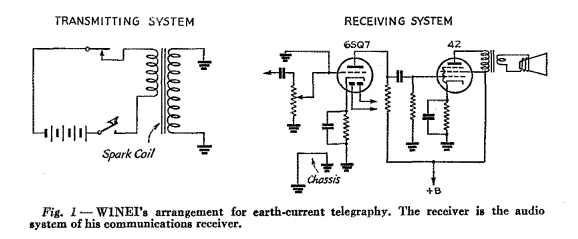During World War II, Amateur Radio was off the air for the duration. However, unlike the situation in the First World War, hams were allowed to keep their equipment, and there were no restrictions on listening. Hams were eager to communicate, and with radio unavailable, they were eager to explore other possibilities. Starting with the March 1942 issue of QST, each issue included an experimenters’ section, which discussed many of the possibilities. Among the possibilities were carrier-current radio over power lines, and modulated light beams.
The first ideas started to trickle in 75 years ago this month in the April 1942 issue, and some of the first experiments focused on ground current communications. Leslie C. Merrill, W1NEI reported his preliminary results with the schematic shown above. The receiver consisted of the audio section of his receiver, and the transmitter consisted of the venerable spark coil from a Model T.
From the transmitter, the signal was fed to ground rods three feet apart. At the receiving end, the ground rods were only two feet apart. Despite the close spacing, he was able to copy the signal fifty feet away.
Merrill reported that he lived out in the country, and had the possibility to space ground rods 3/8 mile apart. By extrapolating his initial results, he speculated that a range of 30 miles might be possible with a similarly equipped station at the other end.
We’ve previously covered similar ideas. In 1940, Popular Mechanics carried plans for a similar setup with a range of about 75 feet. And in the First World War, the Signal Corps had a field buzzer that could be configured with a similar setup. And a 1957 “Quist Quiz” showed a similar setup using a telephone, and even noted that old timers would be familiar with such a hookup.


Pingback: 1918 Ground Current Telegraph | OneTubeRadio.com